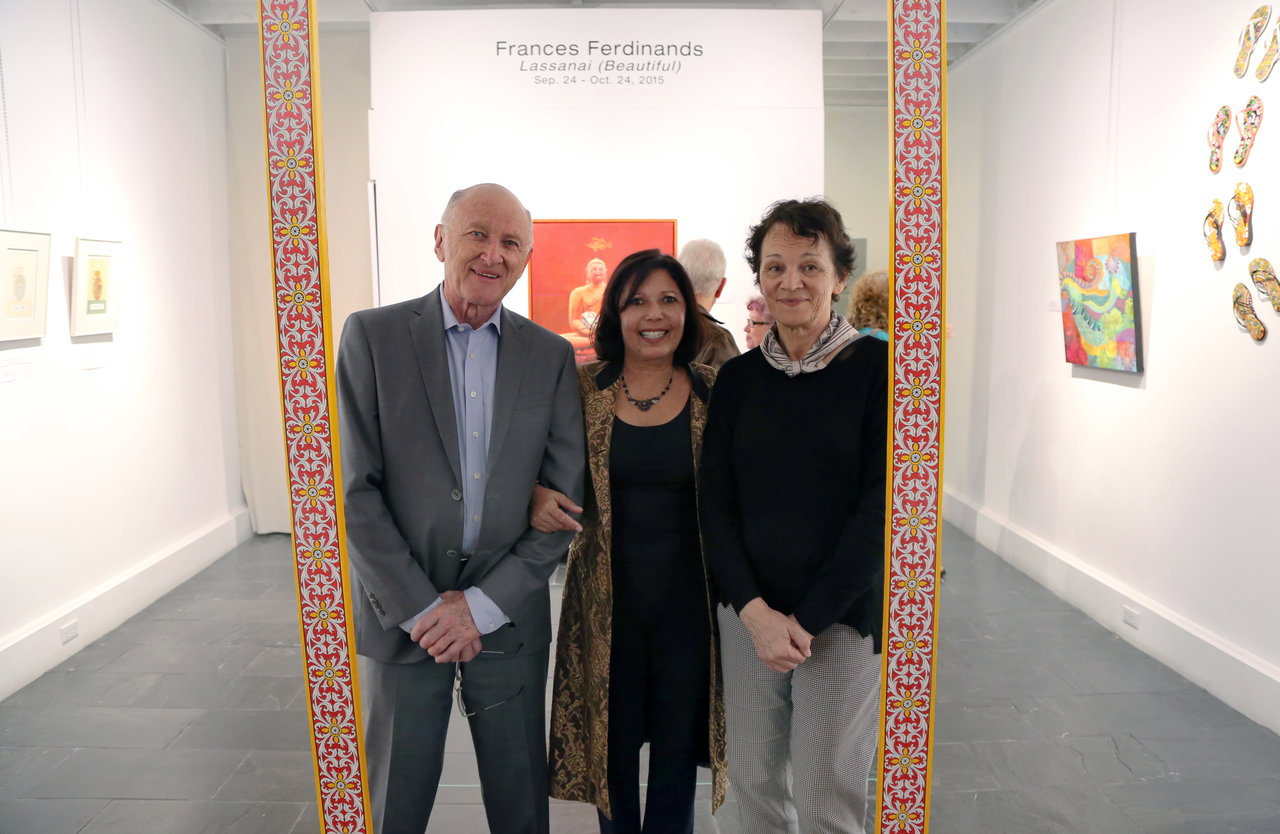 Articsók Gallery co-directors, Peter Alexander Por (left) and Csilla Csiki (right) with artist Frances Ferdinands (centre) framed by “Border Crossing”. Courtesy of Articsók Gallery
Articsók Gallery co-directors, Peter Alexander Por (left) and Csilla Csiki (right) with artist Frances Ferdinands (centre) framed by “Border Crossing”. Courtesy of Articsók Gallery
Interview with Frances Ferdinands (F.F) by Haafiz Karim (H.K)
Frances Ferdinands currently has a solo exhibition, titled Lassanai (Beautiful), at Articsók Gallery.
H.K: Frances, you mostly delve into your culture and your background for inspiration. What makes Lassanai different from your past ones?
F.F: Lassanai is a result of looking at a particular and important part of the Sri Lankan culture, its official religion, Buddhism. The Image Houses of Buddhist Temples tell the story of Buddha in pictographs. I visited many and learned about the Kandyan versus Southern styles of painting. Then I chose to focus on the floral motifs that were present in all of these Image Houses. My recent past work was mostly related to my own hybridity as a Sri Lankan Canadian. This show is somewhat a continuation of my earlier, 2007 exhibition, “Food for Thought”. In that I used Sri Lankan images combined with western ones, like the Buddha embracing Wonderbread, giving them social and political references. These two paintings are also included in this exhibition. Lassanai is different from my previous shows in an experiential way: “26” and “Border Crossing” are installations, the latter is being interactive.
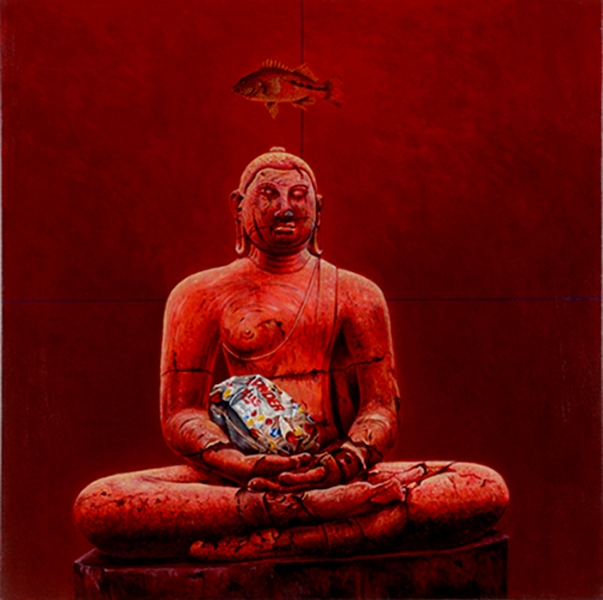 The Red Buddha ( Buddha embracing Wonderbread), acrylic on canvas, 30″ x 30″. Courtesy of Articsók Gallery
The Red Buddha ( Buddha embracing Wonderbread), acrylic on canvas, 30″ x 30″. Courtesy of Articsók Gallery
H.K: Your exhibition is a culmination of a three month stay in your homeland. What was the most important experience in this particular visit and how did you transform it to Lassanai?
F.F: I arrived in Sri Lanka in early January, 2015 on the eve of the Presidential Election. The capital city, Colombo, was deadly quiet as everyone stayed indoors fearing a violent coup was going to erupt but the transition to a new president was peaceful. This resulted in an atmosphere of optimism by all, and a feeling that the 26 year civil war could finally be put behind them. I felt this optimism the entire time I was there and it is revealed in the title of the show and the work. The center piece of the exhibition “26” is a direct expression of this, as each pair of slippers memorializes one year of the war, and – through their beauty – they also symbolize steps into a new, positive era. The hand-painted designs of the slippers are inspired by floral motifs found in the Buddhist Temples I visited. I wanted to combine the highly spiritual motifs with something as lowly and ubiquitous as the slipper – symbolizing the aspects of human life.
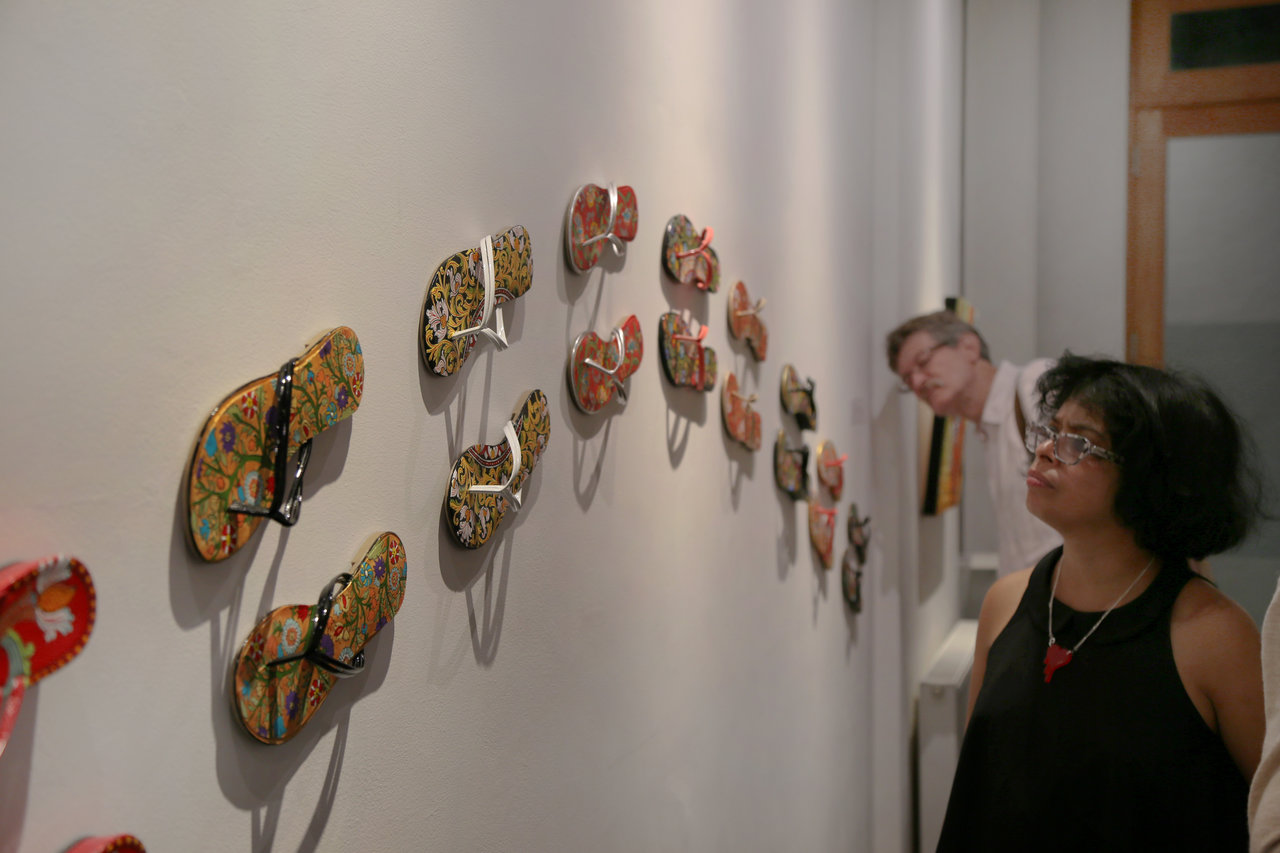 Guests looking at “26”. Courtesy of Articsók Gallery
Guests looking at “26”. Courtesy of Articsók Gallery
H.K: Vinyl has been an important medium in your recent work. Why vinyl particularly? Can you tell us more about this technique and the procedure of creating your pieces.
F.F: I work with acrylic paint. I knew that I wanted to paint 26 pairs of slippers. When I began the process I was painting directly on the foot-bed of the slipper. The technical difficulties of matching the two feet of a pair – one the mirror image of the other – was enormous and the process slow. I came upon the idea of creating about 10 different designs and having them printed on vinyl which adheres to the slipper remarkably well, and takes well to acrylic paint since vinyl is a plastic, as is acrylic. So I had the designs printed and then glued them onto each slipper with an acrylic gel product. I used this method in creating “Border Crossing” as well.
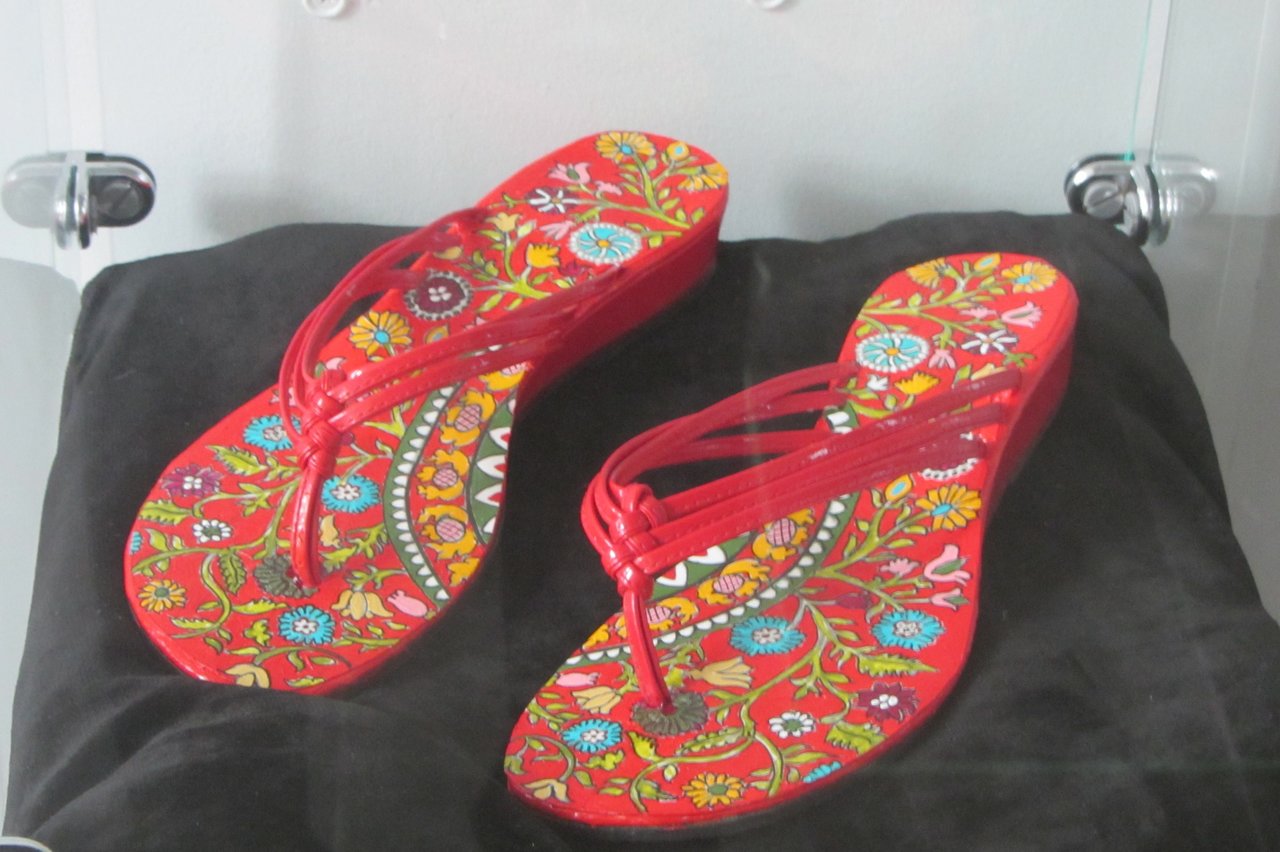 One of the “26” in a glass case. Courtesy of Articsók Gallery
One of the “26” in a glass case. Courtesy of Articsók Gallery
H.K: Your “Atomizer” collection romanticizes quite a stark symbol. What inspired you to create these particular paintings?
F.F: I was looking at the silhouette of a hand grenade, and the elegance of its shape was reminiscent of a vintage perfume atomizer. I also liked the ‘perfume spray’ metaphor. Again I wanted to create beauty within an object of mass destruction. I also wanted to reference the place of beauty within the intersections of war, religion, and commerce throughout history. Each atomizer has a particular reference to the history of the country, its colonization, its exploitation, and so on.
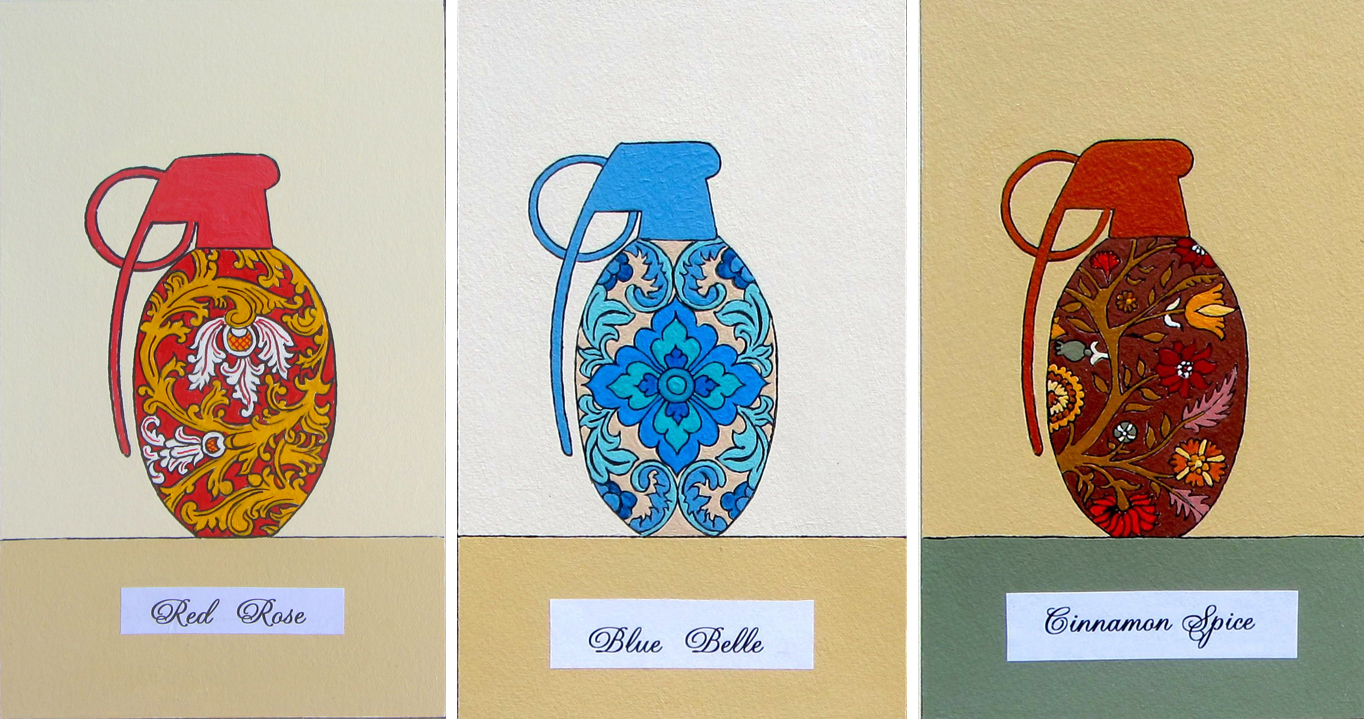 Three of the Atomizers. Courtesy of the artist
Three of the Atomizers. Courtesy of the artist
H.K: There is somewhat of a mystical appeal to your recent journey to Sri Lanka. During this visit you studied traditional fine art and craft with two local masters. What was your greatest lesson? How did you apply their teachings in a more contemporary interpretation?
F.F: I studied with two mentors who practice a form of art and craft that is disappearing in the country. I was interested in learning the traditional techniques and rules of how to paint in that historic tradition. I had not worked in such minute detail in many, many years.
The greatest lesson was: a striving for perfection all the while knowing it was unattainable. The process was in many ways a meditative activity. In creating the work for the show, my intention was to use those techniques and designs I had learned and re-contextualize and re-vitalize them. Many of these floral motifs were simply decorative ornamentation around the perimeters of ceilings, doors, walls of temples. I have, in a very contemporary way, given them a new meaning.
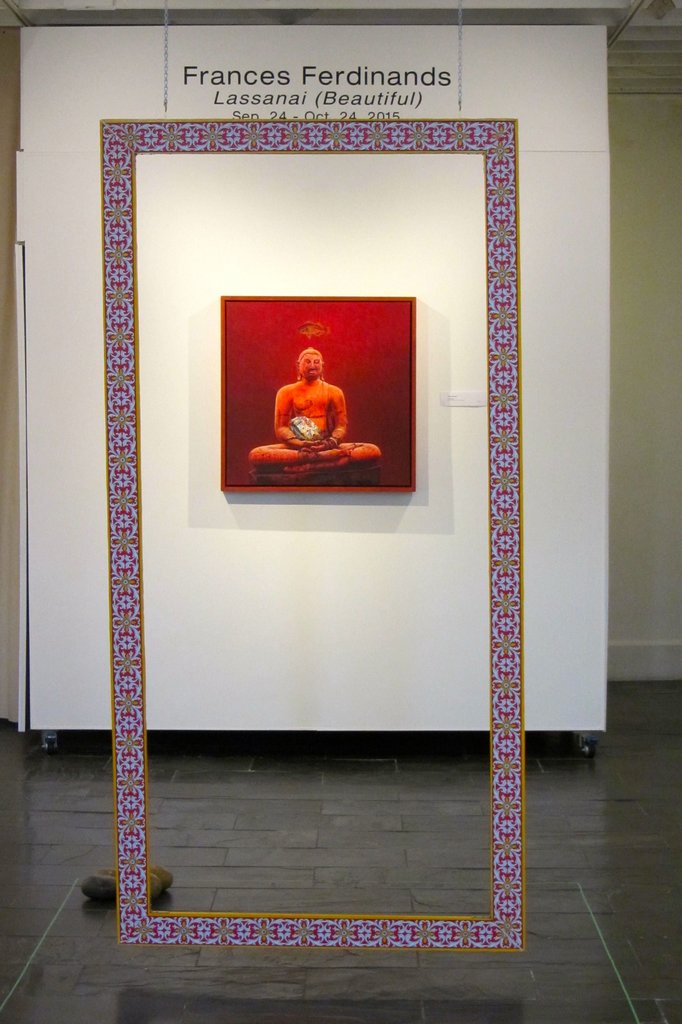 Installation view with “Border Crossing”. Courtesy of Articsók Gallery
Installation view with “Border Crossing”. Courtesy of Articsók Gallery
Given the current world situation, the installation, “Border Crossing” is very germane. Again I took two border patterns and transformed them into a portal, a crossing, in which one carries an object (in this case a round stone) over a threshold. I wanted the viewer to experience the microcosm of a journey; one that combines the spiritual with the physical. This particular piece is the beginning of a larger work in which I’ll take border patterns from the spiritual houses of various cultures and create multiple crossings.
*Exhibition information: Frances Ferdinands: Lassanai (Beautiful), September 24 – October 24, 2015, Articsók Gallery, 1697 St. Clair Avenue West, Toronto. Gallery hours: Wed – Sat, 12 – 6 p.m.

Excellent show and interview!
I live in Sri Lanka. I had the pleasure of getting to know Frances during her recent visit here. I know that she is one hybrid who can bring cultures colser. Someday I hope to see her exhibit in Sri Lanka.
Hi Francis
Congratulations on the exhibition and interview
Well done .
What a wonderful interview, Frances. And beautiful and thoughtful work. I remember 35 years ago at the Merton and “These Boots are Made for Walking”. You have always done interesting work. Will definitely come to see this recent exhibition. Congratulations.
Wow! What a brilliant interview. Quite a fascinating and appreciable insight into Frances’ exhibit. Looking forward to the next display. Congratulations!
Enjoyed the show, and the article too, very much.
This thoughtful and rich interview adds depth to Frances’ challenging and powerful exhibit. There is always a significant sociological message and playful irony in Frances’ art, raising her work to a higher level.